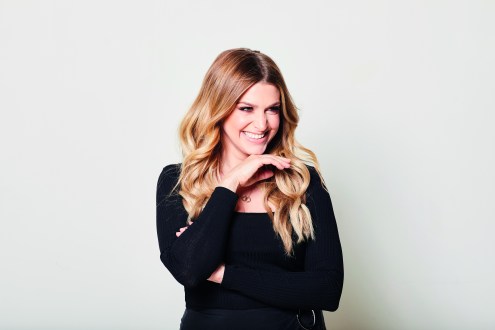How to get over fear: I tried tapping to swim with sharks
When psychotherapist Hilda Burke decided to learn tapping, an empowering east-meets-west therapeutic technique, she had no idea how powerful its effects would be

6 minute read
Have you ever imagined what it’s like to be 15 metres below sea level without an oxygen tank and to have three bull sharks slowly circling in the deep blue 20 metres beneath you? Well, I experienced exactly that in the middle of the Sea of Cortez, off Mexico’s Baja Peninsula.
It was blissful… But that is the end point of my story. To be able to calmly experience the majesty of those moments underwater required a personal journey, which commenced the previous week in northern California.
Unlock the negativity vault
As a psychotherapist, I had long been interested in exploring the fi eld of energy psychology, a method of therapy that combines Eastern approaches to the mind and body with Western psychology and psychotherapy. To that end, I finally booked a week-long professional development course in tapping – or EFT (Emotional Freedom Technique) as it’s sometimes called – at the renowned Esalen Institute in Big Sur, California.
My goal was to become a competent EFT practitioner, adding another skill to my therapeutic toolbox. During the week’s course, working both individually and in pairs, we used tapping as a means to explore distressing past events and firmly entrenched negative beliefs. I quickly began to see its efficacy, particularly in comparison to talking therapy, where energetic and behavioural shifts can take months, if not years, to witness.
Best described as an ‘emotional form of acupuncture’, tapping works by unblocking negative energy stored within our bodies, which can manifest as thoughts and ideas, such as ‘I never get anything done’ or ‘I leave everything until the last minute’ or ‘I won’t ever make any money’. It’s based on the belief that we hold our thoughts and feelings as energy in key physical points of the body (which correspond with the acupressure points that were identified in traditional Chinese medicine several millennia ago) and that by lightly tapping on these areas, while simultaneously speaking our negative thoughts and feelings aloud, they can start to shift.
Accept the unaccepted
The cornerstone of the tapping technique is the setup statement in which the tapper promises to love themselves, despite having certain attributes or behaviour they struggle with and wish to change. Taking one of the negative thoughts I mentioned as an example, your setup statement would be: ‘Even though I never get anything done, I love and accept myself just as I am.’ You’d then tap gently through key acupressure points in the body, while repeating key words from this phrase, for example ‘never get anything done’.
At the start and end of any exercise, you note down your SUD score (subjective unit of distress – a scale of 0-10 that’s used to track anxiety levels when using tapping techniques; zero being lowest and 10 highest). In the entire week, I don’t recall one instance of someone’s SUD score not dropping using this application.
It seems counterintuitive to love yourself for something that you may have lugged around your whole life, however, what was interesting to me was the way that, once we began being forthcoming with acceptance over that aspect of ourselves, it created space for other thoughts and ideas to emerge.
Finishing the course, I looked forward to applying what I had learned with clients when the opportunity arose. I left Esalen on a cloud, feeling elated from all that I had experienced. I was heading for Los Angeles to catch a flight to Mexico for my next adventure. Then, an hour outside LA, doing 85mph on the freeway, my tyre burst. I somehow managed to veer the car to the hard shoulder, but I was shaken and suddenly under serious time pressure to catch my flight. I felt frozen with panic, then I remembered I’d just spent a week learning a technique that was designed to deal with overwhelming situations like this.
The real menace
So I tapped on my fears that I might miss my flight. Within five minutes, my SUD score had dropped from an eight to a four. I still felt the stress of the situation but it was manageable. Crucially, it helped mobilise me to deal with the predicament, getting the car hirer to call a roadside assistance company, which turned up within 15 minutes. In the end, I made my flight quite comfortably.
The big challenge, though, was to come in Mexico, where I had booked myself on a freediving course – diving without an oxygen tank – with the I AM WATER foundation. I’d assumed that everyone in the group would be a beginner like me – in fact, a few were accomplished freedivers, half had been competitive swimmers and the remainder were career high-flyers, several of them TED or Davos speakers.
At this point, the sharks (who are uninterested in humans as long as they have access to a range of sea life) were the least of my worries. Instead, what threatened to devour me were my anxieties around feeling unskilled, not sporty and being an underachiever.
Could I tap my way out of this? I worked on some of the prejudgements that had come up: ‘I’ve never been good at sports’; ‘I was the last kid to be chosen for any team’; ‘I don’t know what I’m doing’. As I worked through the tapping process, I was surprised how quickly these thoughts transformed into: ‘I’m unskilled because I’ve never done this before.’ ‘I’m here to learn and try something different.’
I can hear freedom
The next day, I dived down to the end of the training rope – six to eight metres – and felt excited. As the depth increased, I continued to remain confident in my ability, my breath, my body’s supply of oxygen. Eventually, I dived to 15 metres, close to the sharks – but, for me, the real achievement was getting out of my own way and letting myself explore my limits without prejudgement.
In so many ways, we use negative thoughts about ourselves to limit our achievements or, worse, to block us from loving ourselves. For many of us, it may feel challenging to love ourselves despite our ‘issues’ or flaws. For me, it was the thought that I’m not as much of a high achiever as others; I’m not as naturally sporty. Although I know rationally that I’ve found fulfilling ways to channel my talents, sometimes these old beliefs make their presence felt.
What was important was telling myself aloud that I liked myself, in spite of this ‘flaw’. This allowed me to recognise that I wanted to learn and I wasn’t there to be an expert. It’s only when we can love ourselves for what we perceive ourselves to be – our imperfect selves – that change can begin. Not for nothing is tapping called ‘emotional freedom technique’. As Carl Rogers, the father of humanistic psychology, said: ‘The curious paradox is that when I accept myself just as I am, I can change.’
Hilda Burke is author of ‘The Phone Addiction Workbook’ (Ulysses Press, £13.99)
Image: Getty








